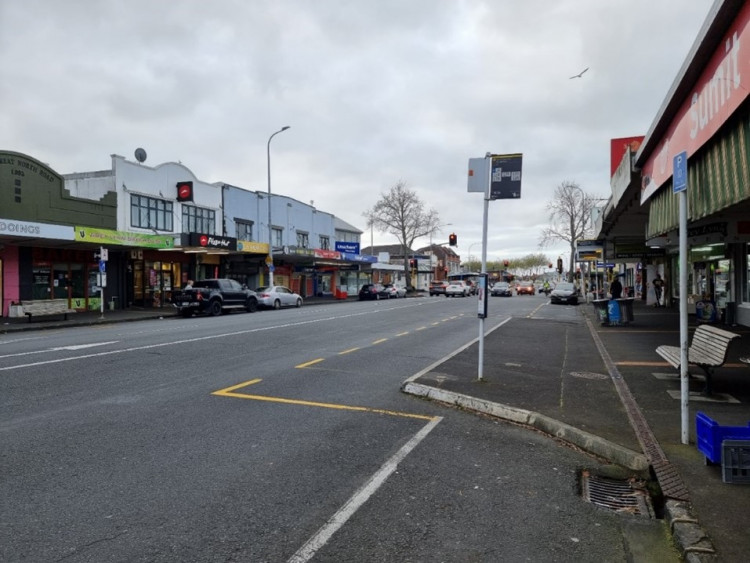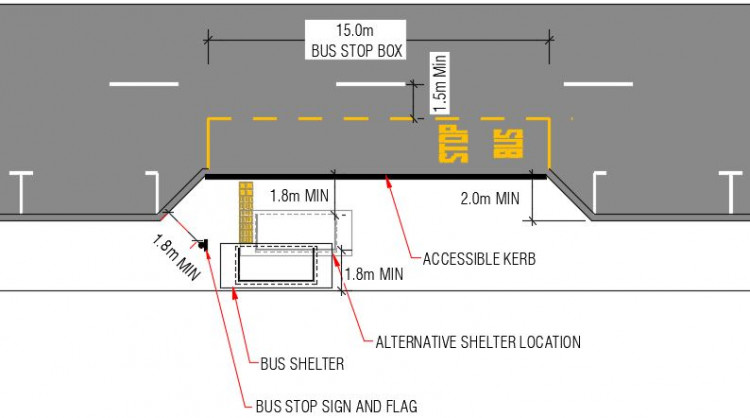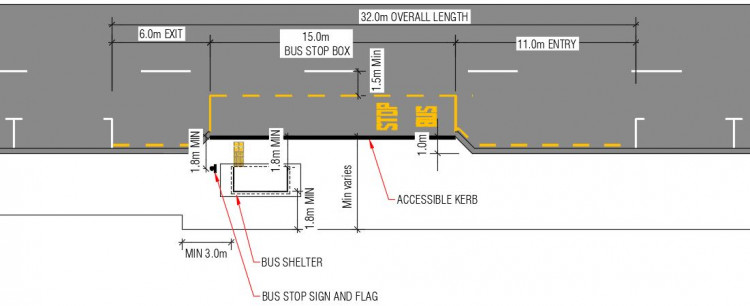Note: The Government Policy Statement on land transport 2024-2027 (GPS) sets an expectation that the NLTF will not be used in the funding of in-lane bus stops under certain activity classes.
In-lane (also called ‘in-line’) bus stops enable public transport to stop within traffic lanes rather than needing to exit and re-enter the traffic lane. In-lane bus stops are often achieved through use of bus boarders, which are arrangements where the kerb line is extended outwards for a bus stop.
In-lane (also called ‘in-line’) bus stops enable public transport to stop within traffic lanes. Traditional kerbside bus stops require buses to exit the traffic lane and manoeuvre into a kerbside bus box. This delays buses due to manoeuvring time and the need wait for a gap to re-enter the traffic stream. In some cases, particularly when lead-in and lead-out space is inadequate, drivers may not pull in close to the kerb, resulting in access issues, particularly for people with constrained mobility. In-lane bus stops eliminate these sources of delays for buses and improve the ability for the bus to reach the kerb line, making it easier for people using wheelchairs or with prams to get on and off the bus. They can also provide other benefits such as reduced parking loss and better footpath operation.
While in-lane bus stops do require private vehicles to wait behind the buses when they stop at bus stops, this (usually small) delay is often outweighed by benefits to bus passengers. Despite the public’s concerns, there is usually little actual impact on general traffic flow, especially on lower volume roads and in main urban and suburban centres where managing general traffic speed is important. More information about benefits and implementation guidance is provided further down this page.
In-lane bus stops are usually achieved though bus boarders, which are arrangements where the kerb line is extended outwards for a bus stop (see the figure below). Typically, the bus boarder replaces roadway that would otherwise be for parking or a traffic lane.

Full width bus boarder in Auckland. (Source: Thomas Chu)
Bus boarders can be full width (minimum 2m wide) or half width (about 0.5–1.5m wide).
Full-width bus boarders (see the figures above and below) require the shortest kerbside length of all the layouts. Lead-in and lead-out space is not usually needed, only the length of the marked bus stop box itself (15m which includes ample room for bike rack deployment).

Full-width bus boarder for a single standard 13.5m-long tag-axle bus. (Source: Auckland Transport) View larger image [JPG, 42 KB]
Half-width boarders need a lead-in length of about 11m and lead-out of about 6m (see the figures below)
Half-width bus boarders are often a useful compromise solution when:
The length of the bus boarder along the outer kerb line should correspond to the length of the bus stop box. Where kerbside space is restricted, consider a shorter bus boarder platform, but it should usually measure a minimum of 9–10m along the outer kerb line to allow access to both sets of bus doors.
Designers can be flexible when deciding the optimal length of the bus boarder to accommodate the trade-off between parking provision and additional footpath space given the local context and project objectives.

Half-width bus boarder in Lambton Quay, Wellington. (Source: Joanne Tan)

Half-width bus boarder for a single standard 13.5m-long bus. (Source: Auckland Transport) View larger image [JPG, 46 KB]

Half-width bus boarder – retrofit to existing street kerb line (alternative 1). (Adapted from Auckland Transport) View larger image [JPG, 45 KB]

Half-width bus boarder – retrofit to existing street kerb line (alternative 2). (Adapted from Auckland Transport) View larger image [JPG, 54 KB]
The benefits of bus boarders are that they:
We recommend using bus boarders when:
To determine the appropriateness of in-lane or kerbside bus stops based on local context, use our In-lane bus stop calculator tool. This tool uses traffic volumes, bus passenger volumes, and bus dwell times to determine which bus stop layout is optimal in terms of reducing overall travel time delays to users.
In-lane bus stop calculator tool [XLSX, 24 KB]
Other considerations when deciding whether to use in-lane bus boarders are as follows.